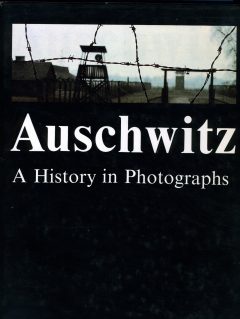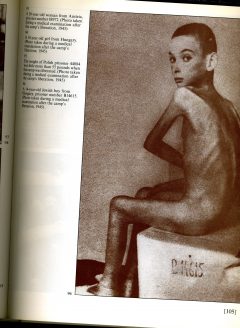 |
 |
[Click the photos for a larger images. Opens in a new window.]
Name of the exhibit: “I recognized myself only because of the number”
Submitted by: Hilda Bleyer and family
Date of origin: After liberation, January 27, 1945
Origin of the object: “Auschwitz: A History in Photographs”, Auschwitz-Birkenau State Museum, 1993, (ISBN 8305126439). First published in Polish in 1990 as “Auschwitz: Crime Against Humanity” compiled and edited by Teresa Sweibocka.
Description: The photograph (on page 105 in the book) shows an emaciated 14-year-old Jewish boy from Hungary, identified only by a prisoner number. It was taken during a medical examination after the liberation of Auschwitz-Birkenau by the Soviet Army in January 1945.
Voyage to Ottawa: Stephen (István) Bleyer, was a 64-year-old Holocaust survivor, an architect and the President of the Montreal Holocaust Memorial Centre. He was an active advocate for Holocaust education and frequently shared his experiences with many different audiences and particularly with students. In January 1994, Stephen walked into a local bookstore where he noticed a new book: “Auschwitz: A History in Photographs”. He picked it up and, leafing through its pages, discovered this photograph of a 14-year-old boy identified only by a number – B14615. It is the same number Stephen had tattooed on his arm; it is his first glimpse of himself as a child at Auschwitz.
“Je ne cherche pas à expliquer ce genre de chose. Mais je suis content que cette photo existe comme preuve supplémentaire de ce que j’ai vécu, de ce que des hommes ont fait à d’autres hommes.” Stephen Bleyer in Le Devoir
(“I can’t really explain this. But I’m glad that this picture exists as further proof of what I lived through, what some people have done to others.”)
Shortly after discovering the photograph, Stephen wrote to Teresa Swiebocka, the senior curator at the Auschwitz-Birkenau State Museum and editor of the book. The photograph, the response from Jerzy Wroblewski, the Director of the Museum, and the archival documents including a German list of prisoners, a Polish Red Cross list of survivors and Soviet medical records Stephen received from the Museum, help to tell the story of how he survived the end of the war.
As Stephen told the Montreal Gazette, “I had two feet that were frozen with open wounds. I wasn’t in a position to walk and I was very weak” and so he avoided the Death March that marked the Nazis abandonment of Auschwitz-Birkenau. Along with 2,500 others, he was left to die in the camp ‘hospital’. But the German attempt to set fire to the remaining camp buildings failed and Stephen lived to see a Soviet officer arrive: “he was wearing a white cape and told us in Russian that we were free.”
Despite the state of his seriously infected feet, a lung infection (pleurisy) and his 23.5 kg weight as a result of starvation, three months after liberation Stephen would recover enough to travel back to Hungary.
In the year following his discovery of the photograph, Stephen was a frequent voice in the media for the commemoration of the 50th anniversary of the liberation of Auschwitz-Birkenau. He was now sharing his story and the lessons he had drawn from his experience with a much wider audience. Sadly, Stephen passed away in March 1997.
After several years in Hungary and then as a Displaced Person in Italy, Stephen Bleyer arrived in Montreal in 1951, he married Hilda Agulnick Bleyer in 1961, and they had two children. Hilda later moved to Ottawa where she is an active volunteer with the Centre for Holocaust Education and Scholarship (CHES).